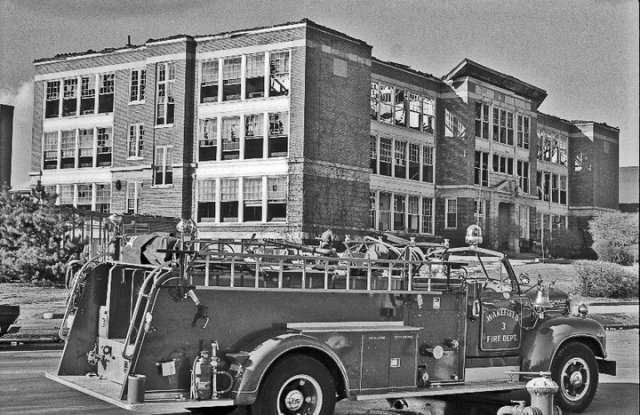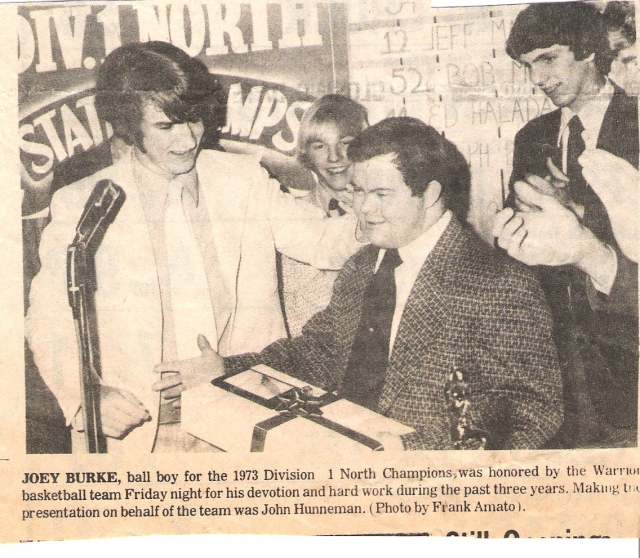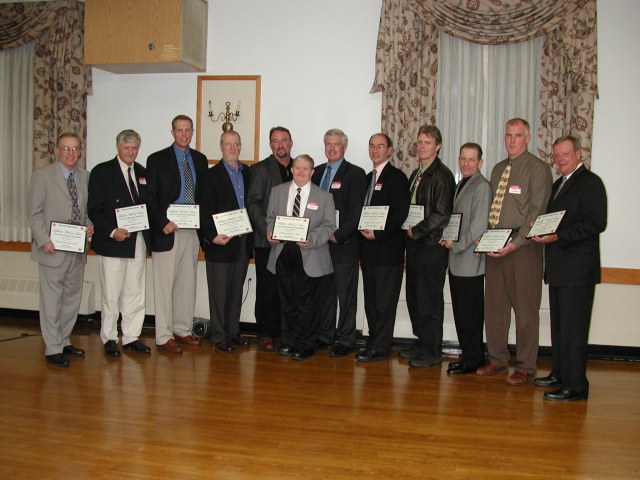Someone contacted me a while back and said she’d heard I’d written a piece about the 1973 State Champion Wakefield High School basketball team.
In fact, I had.
Almost three years ago I contacted editor Peter Rossi at the Wakefield Daily Item with an idea about writing the story to mark the 40th anniversary of the win. Rossi was the sports editor of the Item in 1973 and I was the high school senior — and team manager — who covered the team for that newspaper.
The woman said she’s missed the story when it ran in the Item in March of 2013.
Here it is. Enjoy.

By the fall of 1972 Wakefield was a town tired of being on fire.
Beginning in March 1971 a series of more than a dozen suspicious fires had the town on edge. Homes, restaurants, Wakefield’s only movie theater and a huge industrial park, once the home of the rattan business of Cyrus Wakefield – the town’s namesake – were destroyed in often spectacular blazes.
On December 12, 1971 a gut-punching fire destroyed the landmark three-story Atwell Building on Main Street which, since 1923, had served the community as both a junior high school and, at the time of the fire, was the older half of the Wakefield High School campus.

An arsonist, who turned out be a Wakefield police officer, was later arrested but the damage caused by the fires had both scarred and scared the town.
Rising from the ashes and the inconvenience of their partially destroyed campus, in late 1972 a group of determined and largely unknown varsity basketball players lit a fire of their own, this one under not only their fellow students but the entire town.
The 1972-73 Warriors’ boy’s basketball team earned the nickname “Cardiac Kids” as they captured the Division 1 North State Championship – the school’s first ever – and gave the town, still shell-shocked from the destructive fires, a reason to cheer.
That championship game, an overtime thriller over arch-rival Lexington at the old Boston Garden, took place 40 years ago, on March 6, 1973.
…
The destruction of the Atwell Building in December 1971 forced the high school into double sessions with juniors and seniors attending classes from 7 AM until noon and younger students in class from noon until 5 PM.
This schedule caused havoc for many, including the school’s sports programs.
For the boy’s basketball program it meant splitting practice time between the gym on the high school campus, now the Galvin Middle School, and the modern junior high school on Farm Street which was converted to Wakefield High School several years after the fire.
“I remember leaving school at noon, going to my grandmother’s house to do homework and take a nap before practice, which began about 6:30,” said Ron Sen the Warriors’ “player representative” — a title he preferred instead of Captain — of the ‘72-73 team.
The upheaval caused by the fire likely contributed to the slow start of a young ‘71-72 team, which had just one senior on the roster. However, the team improved as the season progressed, finishing with a .500 record but failing to reach the playoffs.
“There were a lot of reasons to be optimistic heading into the next season,” said Sen. “But nobody really expected us to be among the league leaders.”
However, the senior-laden ‘72-73 Warriors cruised through the regular season posting a 17-3 mark, the three losses coming by a combined total of four points. Two of the losses were to Stoneham 90-89 and 50-49. The other loss was in overtime at home to Lexington, 61-59. However, in the regular season’s next to last game, the Warriors trounced the Minutemen 70-54 at Lexington.
Playing home games in the bandbox that was Wakefield’s gym was a huge advantage recalled Sen.
“It was so incredibly small,” said Sen, “It helped create an environment that wasn’t exactly friendly to our opponents.”
Much of the fan support came from a student group, led by senior Bill Dodds, called the Rowdy Association of Wakefield that filled the home stands and traveled to most away games during the season.
But the Warriors’ biggest advantage, players said 40 years later, were head coach, Ellis “Sonny” Lane, and assistant coach, Dick Kelley.
This was Lane’s third season as the varsity coach. Kelley had coached many of the players since they were freshmen.
In the summer before his first season (1970-71), Lane had gathered the players on the playground behind the Woodville School for an initial meeting.
There he pulled paint cans and brushes from his car and instructed the team to get to work sprucing up the playground court and painting the wooden backboards that were nailed to telephone polls. On one of those polls Lane painted in red, “Tech Tourney ‘73” which is what the state high school basketball tournament was called in 1970.
That was the goal he told the players and Lane began to install the offense, defense and the attitude he said would take them there.
“I have to say my fondest memory of that season would have to be the basketball knowledge that I learned from Sonny Lane,” said Bob Moore, a starting forward and leading scorer on the championship squad. “I went to school for 18 years and remember very little. I can tell you verbatim the call signs of our offenses and defenses that year.”
Others agreed.
“Sonny was ahead of his time,” said Sen. “We had shot charts, statistics, and scouts and used film. Back then others didn’t know much about the other teams they were playing but we did.”
…
Wakefield made the Division 1 North playoffs and drew an overmatched Northeast Regional team in the first round winning 76-23 at Beverly. That game was most notable for the absence of one player, Roger Lapham.
School officials did not to allow Lapham, the team’s only sophomore, to travel to the afternoon contest because, due to the double sessions, he would have missed classes. Still, the one-sided affair allowed everyone on the roster to see action and each member of the Warriors scored.
Next up was Andover, a talented team that had won 17 games in a row but proved no match for Wakefield. The Warriors stormed out to a 28 – 11 half-time lead and cruised to a 57-37 win.
Now it was on to the semi-finals at venerable Boston Garden.
Maybe it was nerves of the big stage or playing the tournament’s No. 1 seed — 22-0 St. John’s Prep — but midway through the second quarter the Warriors trailed 26-12.
But the magic in that old parquet floor apparently was not the exclusive property of the Boston Celtics. Wakefield ran off 12 straight points to cut the lead to 26-24. With six seconds left in the half, Sen made a lay-up and was fouled. He hit the free throw to give Wakefield its first lead of the contest.
But the Warriors weren’t done. Eddie Haladay stole the inbound pass and launched a half-court shot – in the days before the three-point line– that swished through the net as the buzzer sounded giving the Warriors a 29-26 half-time lead.
The Garden crowd, which included several thousand fans from Wakefield, erupted.
“I can still picture Eddie Haladay hitting that shot as the half-time buzzer went off,” said Mike Boyages, Wakefield’s current athletic director and varsity football coach who was a student in the stands that night. “That was an amazing game for sure.”
The Warrior defense held the Eagles to just four third quarter points and Wakefield won 47-41.
The Division I North finals pitted Middlesex League rival Lexington against Wakefield.
“Sonny liked to say ‘who are these guys?’” laughed Sen. “He tried to play up the fact we were a bunch of no-names. Nobody knew who we were.”
Lexington, on the other hand, was the two-time defending state champion.
The Rowdy Association of Wakefield arrived at the Garden in full throat to cheer on the Warriors. A rowdy crowd estimated at about 6,000 shook the building as the contest began.
“I was amazed at how intense that game was,” starting forward, John Pacillo, said recently. “And by all the support we had.”
Covering the contest for the Boston Globe, Peter Gammons wrote: “This was the 1960 World Series, The KC-Miami playoff of 1971 and Havlicek Stole the Ball rolled into one high school game.”
The game was close with Lexington holding a small lead at half-time and 38-35 at the end of three quarters.
With only a few seconds remaining in the fourth quarter Pacillo calmly sank two free throws to tie the contest at 53. A desperation shot by Lexington at the buzzer bounced off the rim and the game went into overtime.
Moore hit two free throws to open the three-minute overtime period and give the Warriors their first lead of the contest at 55-53. Pacillo hit a free-throw to put Wakefield up 56-53; however, Lexington’s Al Dawson hit a layup, was fouled, went to the line to try and tie the game. He missed and Wakefield clung to a 56-55 lead.
With only a few seconds left in overtime, Lexington’s Dawson launched a 45-foot shot that would have won the game, and the championship, had it gone in.
“That shot seemed to be in the air forever,” Pacillo said. “It hit the rim and then the backboard.”
And then it bounced away giving Wakefield the win and Division 1 North title. Thousands of jubilant Warrior fans stormed the storied court to celebrate and help hoist the championship trophy.
…
The state tournament didn’t end that night. A week later Wakefield squared off against Division 1 South champion, Taunton, in the state championship semi-finals played at Boston College in a contest that seemed anti-climactic.
The Warriors were never in sync that night and, although Bob Moore — playing on a severely sprained ankle suffered in practice a few days before — scored 22 points, Wakefield lost 61-58.
“It was probably just as well,” Sen recalled. “Taunton went on to lose by about 30 points in the state championship game.”
The Warriors’ final season mark was 21-4, those four losses coming by a combined 7 points.
…
Four decades later some of the specific memories of that season have faded, but not the sense of pride and teamwork about what was accomplished and the obstacles overcome to make them happen.
“We were fortunate to all come together,” said Pacillo.
“I have carried the lesson of working hard and selfless dedication of all my teammates through my adult life,” said Gerry Durkee.
“It was a very special time,” recalled Sen. “We were all really fortunate to be part of it.”

…
They began playing basketball at Wakefield High not long after Dr. Naismith hung up the peach baskets.
The old Boston Garden where the championship was won 40 years ago is, of course, long gone.
The Division 1 North championship trophy, awarded to the team on that holy parquet floor, has vanished.
“Unfortunately, I have been unable to locate the trophy here at the school,” said Boyages.
The tiny Wakefield High School gym, which was packed for each home game in the ’72-73 season, is scheduled to be demolished later this year in the first phase of the building of the new Galvin Middle School.
“The old gym had become old and weathered just like the players on our team,” laughed Sen.
The Warriors have had other championship basketball teams since the 1973 squad, some more athletic and talented.
However, during a dark period in the town’s history, the magical season of Cardiac Kids provided a reason to cheer and celebrate and memories that have lasted a lifetime.
In 2004, the 1973 basketball team was inducted into the Wakefield High School Athletic Hall of Fame.

…
Where are they now?
The Cardiac Kids of 1973 are in their mid-to-late 50’s these days. Most are fathers and a few are grandfathers. Some played college basketball and one was drafted by an NBA team. Many still live in New England. At least three of them, Sen, Pacillo, and Bob Moore are married to their WHS high school sweethearts
The coaches:
Head coach Ellis “Sonny” Lane, whose Warrior teams amassed a 276-111 record from 1970 to 1987, was elected to the Massachusetts Basketball Coaches Hall of Fame in 1991. He lives in York Harbor, Maine
Assistant coach Dick Kelly, who taught and coached at Wakefield High for 41 years, is retired. After living in North Reading for 35 years, he will soon be moving to New Hampshire.
The players:
Eddie Haladay died unexpectedly in December 1989 in Tewksbury.
Dr. Ron Sen lives in Melrose where he coaches middle school basketball and is the co-host of a local cable sports talk show.
Steve Relihan, who served as an assistant coach on Wakefield’s undefeated 1996-1997 Division II State Championship team, lives in Wakefield and is a realtor.
John Pacillo is an engineer and operations manager with Mexichem Fluor, Inc. in Baton Rouge, Lousiana.
After 29 years as a Massachusetts State Trooper, most of it patrolling Martha’s Vineyard, Bob Moore retired three years ago. He lives in Old Orchard Beach, Maine.
Tom Conomacos, according to his Linked In profile, is the president of Granite State Marketing in Londonderry, New Hampshire.
Dr. J. Michael Joly lives in the Washington D.C. area. Years ago, when Ron Sen was a U.S. Navy doctor serving in Bethesda, Maryland, Joly performed ACL surgery on Sen’s knee.
Gerry Durkee lives in Fitchburg and works in Danvers at Osram Sylvania.
Among the juniors on the squad, Jay Moore plays guitar in an acoustic-comedy-Irish band called “Moore, Wild & Lynch” in Southern Maine.
Jeff Mader lives in Sudbury and is an accounting manager for the Providence and Worcester Railroad.
Ralph Burke is a contractor and lives in Dracut.
Roger Lapham, the lone sophomore on the 1973 squad, went on to star at the University of Maine and was drafted by both the NFL’s Buffalo Bills and the NBA’s Milwaukee Bucs. Lapham lives in Amherst, New Hampshire and is the New England Sales and Marketing Director for Cincinnati Insurance Co.
The team had two managers. Andy Johnson lives in Bedford and works in Wakefield as a principal and consulting actuary for Milliman, Inc.
John Hunneman, who began his journalism career covering the Warriors during the 1973 season for the Wakefield Daily Item, is a columnist with the Riverside Press-Enterprise in Southern California.
Finally, Bill Dodds, who led the Rowdy Association of Wakefield, lives in the Berkshires where he crafts stained glass windows and enjoys playing his banjo.
